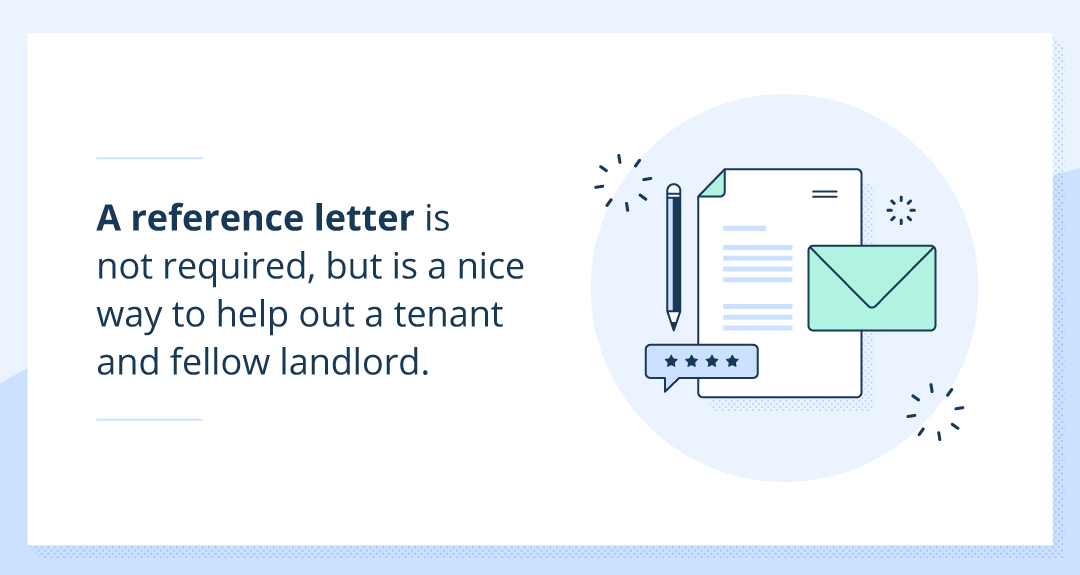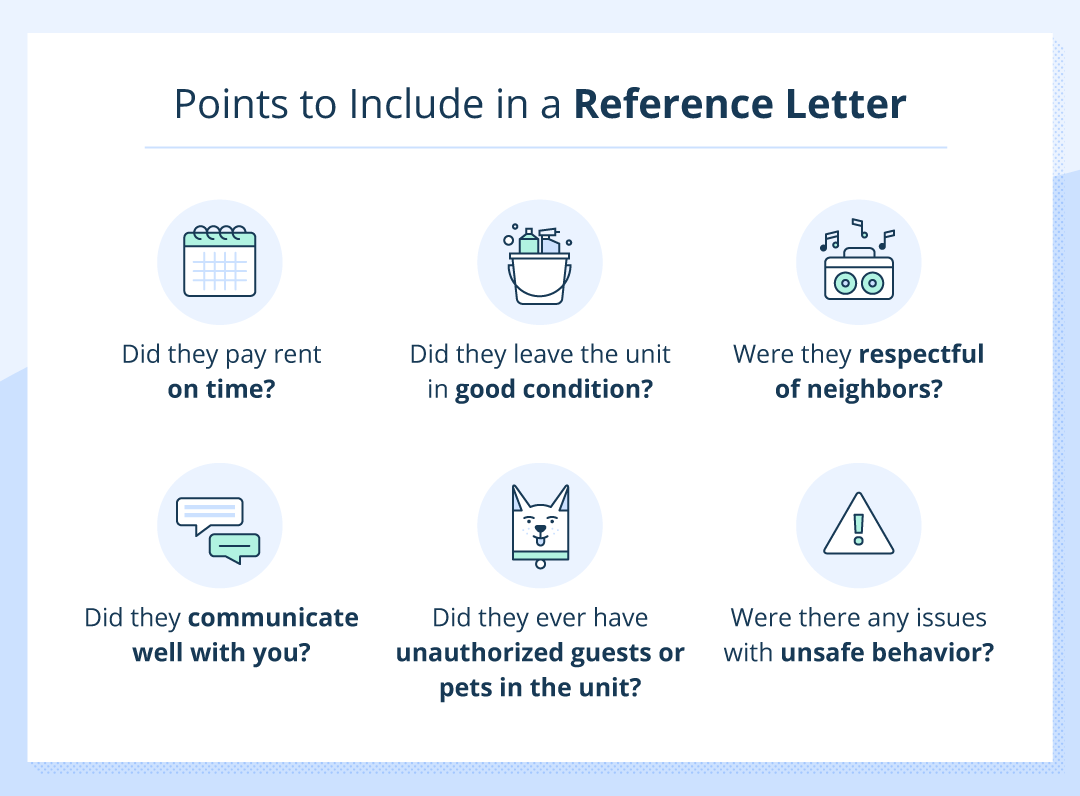Today’s rental landscape is increasingly competitive, especially in high-demand metro areas such as New York City or the Bay Area. Even in many college towns, landlords require potential renters to provide comprehensive financial documentation in their rental applications. New landlords may also require a landlord reference letter written by a potential tenant’s previous landlord. What better way for a landlord to vet an applicant than by asking their former landlord?
Though you are, of course, not required to provide a landlord letter of reference if your tenant asks you to, it’s a good thing to do. Not only are you helping out a tenant who may refer other good tenants to you, but you’re also doing a favor for fellow landlords who may return the good karma to you down the road.

Writing a landlord reference letter doesn’t need to be long-winded or complicated. A short, to the point message about the quality of a tenant is all that is needed. Jump to our printable landlord reference letter sample below, or take a look at our tips for what to include if you plan on writing your own.
What is a Landlord Reference Letter?
A landlord reference letter is a written document from a former or current landlord to a new, prospective landlord. Much like an employment reference, this type of letter speaks to the character and reliability of a potential tenant and whether or not they would be a good candidate for the unit. Providing proof of income and employment is all well and good, but they don’t tell you much about the person and their living habits. This is why many landlords like to receive reference letters from other landlords that confirm the tenant is responsible and respectful as well as financially stable.
7 Tips for Writing a Landlord Reference Letter
If you’re writing your own landlord reference letter, below are a few things to make sure you include. As a general rule, these letters don’t need to be any longer than one page.
1. Think About What You Would Want to Know
For a general starting point, think about what you, as a fellow landlord, would want to ask another landlord about a new tenant applicant. What types of experiences have you had that you know makes a good or a bad tenant? What kinds of information would you want to cross-check about a tenant before accepting them? Keep these questions in mind when writing your landlord letter of reference so that you are providing the most useful information possible to the prospective landlord.
2. Provide Basic Information
Though it might seem redundant to re-state this type of information, unfortunately, some tenants do lie about even their names or their former addresses in order to avoid background checks or make themselves seem like more desirable tenants. Therefore, dot your i’s and cross your t’s by outlining the tenant’s name, your name, the address of the property, how much you charged for rent, and how long the original lease agreement was for.
3. Provide Specific Details

Now, refer back to the first point and think about the specifics you would want to know as a landlord. Did the tenant pay rent on time? If they did pay rent late, by how much and how often? Were they clean and respectful of the unit? Were they quiet and respectful of neighbors? Did they respond promptly to calls or emails? Did they abuse maintenance requests? Were there any issues with long-term “guests” or potential unsafe behavior? All these and more are important background notes to provide on the tenant.
4. Keep Track of Documentation
If you are going to be making any negative comments in your reference letter, you should make sure you have the documentation to back up your claims. Looking good in a landlord reference letter is a big deal to tenants, and rightfully so, as it can be a make-or-break factor in their rental application. For example, if you write that the tenant paid rent late three times over the course of their one year lease, you should keep track of payment receipts or bank deposits to show the tenant in case they dispute your claim.
5. Be Honest
If you’ve had issues with a tenant for the duration of the lease, you’re probably desperate to get rid of them and thrilled that they’re looking for a new living situation. This is certainly understandable, however, you definitely should not lie on a landlord reference letter just to get rid of a bad tenant. Word can get around that you foisted off a bad renter onto another landlord in the community, and no one is going to appreciate that type of behavior. Instead, be honest about a tenant’s shortcomings; what’s a dealbreaker for you may not be a dealbreaker for another landlord.
6. Keep it Short and Sweet
As we mentioned earlier, your landlord reference letter shouldn’t be more than a page. Any longer and a busy landlord probably won’t have the time to read it. Keep sentences short and to the point, with only the relevant details included. For example, if a tenant was late on the rent a couple of times, there’s no need to go into a long-winded complaint about how you called them a dozen times about it before they picked up.
Instead just state that they have been known to pay rent a few days late and can be difficult to contact, but that this ultimately wasn’t a big enough issue for you to take further action. The prospective landlord can contact you if they want any more background information.
7. Make Yourself Available

Speaking of contacting you, it can be extremely helpful for the new landlord if you include a phone number and/or email that they can reach you at. Again, this is definitely not required, but is a nice thing to do, especially if you anticipate a future landlord having questions about what you wrote in your landlord reference letter. If you do decide to include your contact information, make sure you are actually available and willing to answer calls or emails about your tenant.
How Should I Submit My Landlord Letter of Reference?
Ideally, your tenant will provide you with contact information for their new landlord, either an email or a physical address, where you can submit the letter of reference directly. This is mainly a concern with letters that contain any negative feedback about a tenant, as, unfortunately, tenants may alter your letter to reflect better on themselves. However, there’s only so much you can do in this situation if you aren’t able to send the letter directly, which is why it can be helpful to include your contact information within the letter so that the prospective landlord can follow up with you if need be.
Landlord Reference Letter Sample
Now that you know what it takes to write a letter that will be helpful to the new landlord, feel free to download our landlord reference letter sample below for your own use and modify it as you see fit. This template is meant for a positive tenant recommendation, but you can easily change up the second paragraph to suit your needs as well. Tenants can also make use of this form and send it directly to their landlords.

Do your fellow landlords and your tenants a good turn by providing them with a landlord reference letter. It’s low-effort on your part but can make a huge difference to them. To make things even easier, TurboTenant will automatically send previous landlords a reference letter request when using their platform, so tenants and new landlords don’t have to. For more helpful landlord forms, visit the TurboTenant blog.







